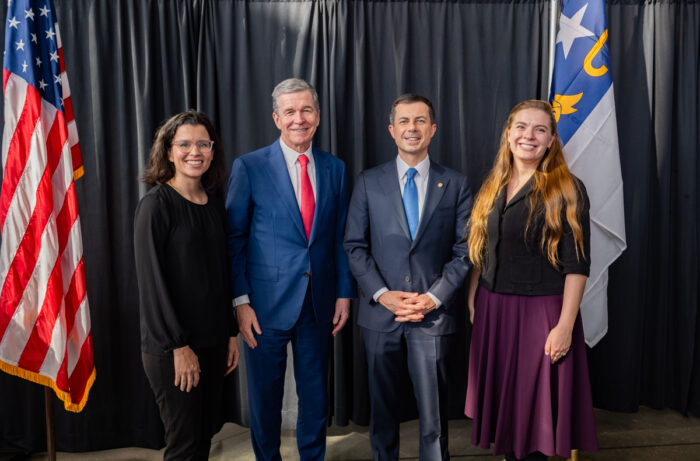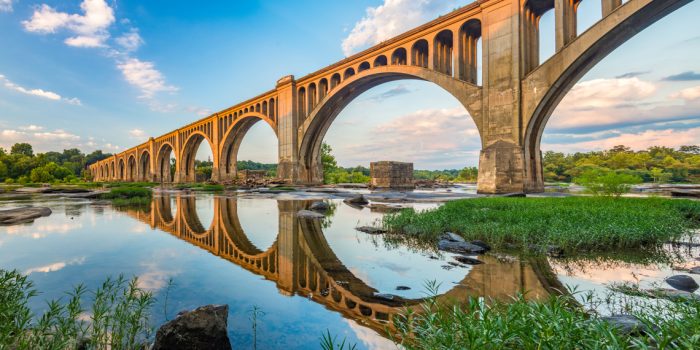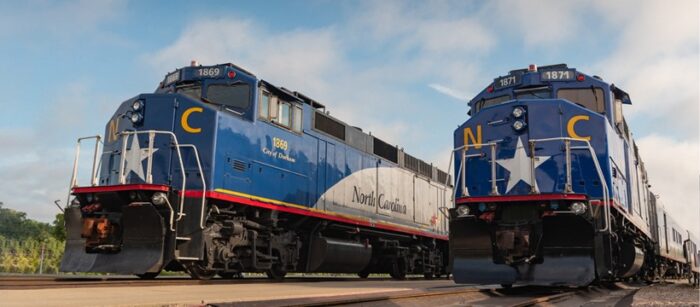All aboard: New funding boosts passenger rail in the South
Expanding and improving passenger rail is a win for the environment, the economy, and travelers. Virginia and North Carolina are leading the charge, investing in faster, more frequent, and more extensive connections between rapidly growing cities.

Federal grants announced recently under the Bipartisan Infrastructure Law will provide a major influx of funds to build upon this momentum and create a cleaner, faster, more convenient passenger rail network.
North Carolina and Virginia — where public and bipartisan political support for rail has been strong, and both states have seen record ridership in the past year — are two of the largest recipients of these funds in the country. However, grants will also advance exciting plans envisioning Atlanta as a major hub for new rail service, as well as restoring passenger rail across Tennessee.
The surge in passenger rail comes at a critical time, as we wrestle with the fact that our highway-focused transportation system is the number one source of climate-changing pollution. SELC has worked for years to advance cleaner alternatives to driving, and these efforts are now bearing fruit.
TRIP POLLARD, SELC LAND & COMMUNITY PROGRAM LEADER
Transforming rail in Virginia
Virginia has emerged as a national leader in rail investment, and SELC has been a leading advocate for this funding.
The Commonwealth launched its first expansion of Amtrak service from Lynchburg to Washington, D.C. in 2009, and since then has restored passenger rail to key cities such as Roanoke and Norfolk for the first time in decades. To date, state funding has added eight round trip, intercity trains per day, connecting Hampton Roads, Roanoke, and Richmond to D.C. — and onward to the Northeast Corridor.
Future plans are even bolder, with the aptly named Transforming Rail in Virginia initiative envisioning a $4 billion program that will connect most of the Commonwealth with frequent and reliable alternatives to driving. The benefits of previous and planned investments are discussed in a recent report SELC co-authored with Virginians for High Speed Rail, that was co-sponsored by three coalitions of business and other groups — New River Valley Passenger Rail, The Greater Washington Partnership, and RVA 757 Connects.
The report documented the rise of rail ridership and found that since 1993, annual travel on Virginia’s passenger trains has eliminated the equivalent of 76 interstate lane miles of traffic while providing over $16.3 billion in economic benefits for the Commonwealth and preventing the release of 5.9 billion pounds of carbon pollution.

Now the federal government has stepped up to the plate, awarding $729 million from the Federal-State Partnership for Intercity Passenger Rail Grant Program to help rebuild and expand the Long Bridge, which is the main freight and passenger rail bottleneck between the Northeast and the Southeast. The Long Bridge project is one of the most important rail projects in the entire country, and it is essential to unlocking the potential of passenger rail in the South. Other recent federal grants will fund new tracks and other infrastructure to help add more and faster trips between Richmond and Washington D.C., with an ultimate goal of 90-minute service between the two cities.
In addition, Virginia was awarded planning grants for new service along other major lines, including up to $500,000 for the proposed Commonwealth Corridor. This east-west route would connect Hampton Roads, Richmond, Charlottesville, Roanoke, and the New River Valley. SELC has long advocated for this critical service.
Want more on the rebirth of passenger rail in Virginia?
North Carolina’s rail revival
North Carolina has also made significant investments in passenger rail, and the Tar Heel State’s rail expansion plans are among the most ambitious in the country. The state is building on the extremely popular Piedmont regional service connecting Charlotte and Raleigh with five daily round trip trains.

In addition to expanding service and improving travel times on the critical Charlotte to Raleigh route, North Carolina is focusing on a new, 110 mile-per-hour service extending the Piedmont regional service from Raleigh to Richmond, and on to Washington, D.C.
Proposed improvements ultimately will provide an approximately four-hour ride from Raleigh to D.C. Last week, the U.S. Department of Transportation announced that it is awarding over $1 billion for construction along the North Carolina section of this project, on top of an earlier $58 million federal planning grant for the entire 162-mile corridor from Richmond to Raleigh.
North Carolina also was just awarded a grant under the new federal Corridor Identification and Development Program to plan for high-speed rail service between Charlotte and Atlanta, as well as grants to plan for several other passenger routes throughout the state.
Building a stronger rail network in the South
While other Southern states have not made substantial passenger rail investments in the past decade, recent awards from the Corridor ID Program will provide planning grants for numerous potential services.
Atlanta is already a global travel hub and is home to one of the world’s busiest airports. Short train rides from Spartanburg, SC, Chattanooga, TN, and Athens and Savannah, GA, would provide cleaner and more convenient ways to travel to the airport or to downtown Atlanta.
One of the biggest gaps in passenger rail service in the South is in Tennessee. Today the state is served by only two passenger trains each day — a north-south long-distance Amtrak service through Memphis. Nashville is one of the largest cities in the country without any passenger rail service. However, the state has proposed rail service linking Memphis, Nashville, and Chattanooga to Atlanta. And Tennessee will now receive a Corridor ID Program grant to advance planning for this corridor.
Passenger rail is back on track in the South, and recent federal grants will accelerate the expansion of this critical transportation alternative.
